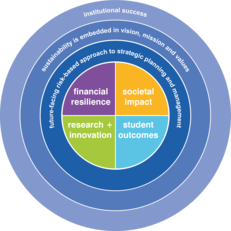Quick Reference Summary
Introduction
Sustainable institutions are successful institutions in the longer-term. They are best placed to be financially and operationally resilient, achieve better outcomes for students, provide greater societal impact and deliver world-leading research and innovation. To help your institution reap these benefits, you as a sustainability leader should work to:
• align sustainability with strategic priorities and develop business cases that clearly articulate the institutional benefits associated with your ideas;
• influence senior leaders so as, over time, to embed sustainability thinking and practice at the very top of your organisation.
Core components of a business case
Your business case should explain what your idea is and why it should be supported, based on its expected benefits. Start by considering whether and how your idea creates value and mitigates risks for the institution (e.g. by reducing costs, improving reputations, meeting regulation, generating income opportunities, etc.) in the context of strategic priorities. Strategic priorities for universities and colleges tend to fall into four overarching categories:
Financial Resilience
Societal Impact
Student Outcomes
Research and Innovation
You should then work to fully understand the risks, opportunities, challenges and benefits (financial and non-financial) of your idea and build evidence to support your claims. This process will involve a significant amount of desk-based research and, in all likelihood, wide-ranging discussions with colleagues and stakeholders. The resulting business case document should contain the following key elements:
- Summary - Overview of the idea, costs (including £%requested) and key benefits
- Project details - Full description, cost-benefit analysis,opportunities, challenges and consequences of no action
- Finances - Financial appraisal and sensitivity analysis
- Implementation - Governance arrangements, timetable, risk assessment, monitoring and reporting
Securing support for your idea
- Your case will be more compelling if you build the following elements into the process:
- Understand decision-making processes in your organisation and work with them
- Set out your vision for what success would look like and develop your case for support around it
- Engage key decision-makers early to understand their priorities
- Think through the risks associated with your idea and explain how they will be managed
- Develop evidence to support claims about the business benefits associated with your idea
- Communicate clearly and concisely when presenting your ideas to stakeholders
Embedding sustainability and creating transformational change
Once you have mastered the art of business case development, you should start looking at how you can influence senior leaders to embed sustainability thinking and practice into your organisation’s vision, mission and values.
This is often a long and involved process, which takes time and perseverance (alongside the development of successive business cases needed to secure resources for new and bigger initiatives).
There are lots of resources referenced in this Guide that will help you to manage this process of change in your organisation, but the following factors are a great starting point:
- Understand peoples’ drivers and start from where they are at
- Look outside the organisation for wider drivers and barriers to change
- Offer up solutions rather than problems
- Work to build consensus on common issues
- Find a senior champion to support you
- Let leaders see the benefits of sustainability with their own eyes
- Don’t be in a rush; leave time for ideas to soak in
- Celebrate success (linking it to institutional priorities)
- Be pragmatic; learning when to let ideas go
- Develop the right knowledge and skills to navigate complex situations
- Expect resistance and develop strategies to boost your resilience





 Except where otherwise stated, content on this site is
licensed under a Creative Commons Attribution 3.0 License.
Except where otherwise stated, content on this site is
licensed under a Creative Commons Attribution 3.0 License.
